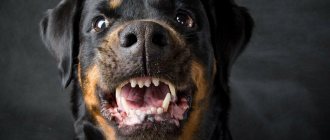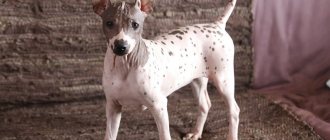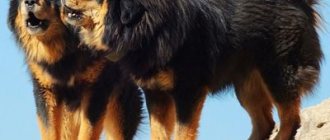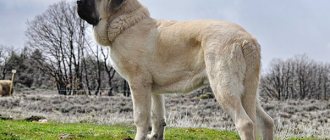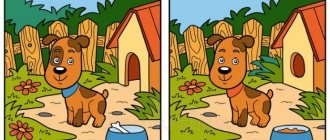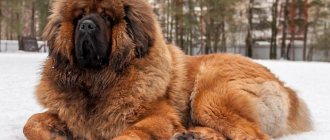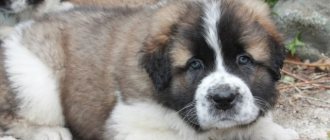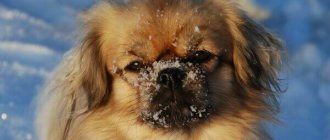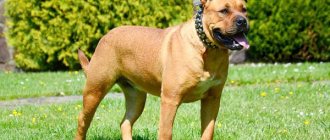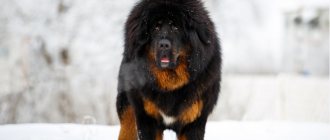Rating of the 10 best dry food for the Tibetan Mastiff
| Place | Name | Rating | Price, rub. |
| 1 | Belcando Junior Maxi for large and giant breed puppies from 3 to 18 months (15 kg) | 10 / 10 | 5 214 |
| 2 | Acana Puppy Large Breed, 11.4 kg | 10 / 10 | 5 050 |
| 3 | Royal Canin Maxi Adult, 15 kg | 9 / 10 | 4785 |
| 4 | Almo Nature Holistic beef 12 kg | 9 / 10 | 4279 |
| 5 | Purina Pro Plan Optiderma for healthy skin and coat, salmon with rice, 14 kg | 8 / 10 | 4113 |
| 6 | Brit Care lamb with rice 12 kg | 9 / 10 | 3999 |
| 7 | OUR DIET WITH BEEF, 15 kg | 7 / 10 | 1670 |
| 8 | Pedigree for healthy skin and coat, beef, 13 kg | 7 / 10 | 1399 |
| 9 | CHAPPI MEAT ABUNDANCE WITH VEGETABLES AND HERBS, adults, 15kg | 7 / 10 | 1381 |
| 10 | ALL DOGS (13 kg) Dry complete | 6 / 10 | 1153 |
Dry dog food is a complete nutritious diet for a pet, developed taking into account the physiology and characteristics of the animal. It contains carbohydrates, fats, proteins, and amino acids in a balanced state. When choosing, pay attention to the composition. The product must contain fats of animal and plant origin and natural ingredients. This is what dogs should receive to be healthy and cheerful.
Care and maintenance of the Tibetan Mastiff
Proper care and feeding of the Tibetan Mastiff is the main task of the dog owner. A Tibetan Mastiff dog cannot be kept in an apartment. It is created for an enclosure or yard, where it can become an invisible shadow and make sounds only in case of threat or necessity.
The Tibetan Mastiff has a terrifying appearance, especially when the dog bristles, causing its thick fur to stand on end. From childhood, the dog must be taught to follow the owner's commands. When communicating with a dog, you need to remain an authority figure and not be gentle.
The most difficult task in caring for a dog will be grooming. The procedure of combing and cutting a Tibetan Mastiff causes enormous pain. It is better to take the dog to a specialist. The dog sheds once a year in the spring. Dogs of this breed are contraindicated for allergy sufferers.
To maintain excellent physical shape, the dog needs constant long walks and active exercises. The dog must run and hunt. It is also necessary to brush your pet every week with a large, stiff brush. During the molting period, this procedure should be carried out more often.
Dogs of this breed do not have a strong odor, which makes it possible to wash your pet less often. Their cleanliness is their distinguishing feature. Dogs always look clean and well-groomed.
It is important to remember that the dog’s physical activity is calculated taking into account the dog’s feeding characteristics.
Feeding
Diet composition
The average calorie content of 100 grams of pet food is 450-470 kcal, but the nutritional value of the product is also important.
Take the Attention Test! Find 10 differences! (click right here!)
Find the answer Are you bothered by some problem or question? Enter “Breed” or “Name of the problem” into the form, press Enter and you will find out everything about the issue that interests you.
Mixtures are created from the following components:
- Proteins obtained by dehydration from meat - 25-32%;
- Cereals and legumes: wheat, rice, corn, barley - up to 21%;
- Fish (from 3 to 20-25%);
- Eggs - 3-5%;
- Plant components and extracts: vegetable fiber, fibers, extracts from pharmacopoeial plants;
- Animal fats - 8-10%;
- Minerals, vitamins and antioxidants;
- Preservatives - natural (class above Premium) or chemical.
Low-grade granules contain an extract from offal (up to 10-15%), and the concentration of meat or fish is not higher than 5%.
Choice
Mixed feeding is prohibited, so dry mixtures should serve as the main ingredient of the menu. As a result of the work of breeders, the mastiff has acquired a genetic predisposition to diseases of the cardiovascular system and digestive tract, and sick animals require a dietary diet.
A separate menu is selected for puppies, pregnant and lactating bitches, and aging individuals.
The granules should be dosed according to the manufacturer's instructions. Overfeeding is dangerous to health and can shorten life expectancy.
Nuances of diet planning
For a dog to grow up healthy and strong, it needs to be fed properly. Kennel owners must take into account the rules for preparing a diet from the moment the puppy is born. It is necessary to take into account the characteristic diseases of this breed in order to prevent their occurrence due to improper nutrition. Mastiffs are prone to the following pathologies:
- Joint dysplasia. It occurs due to obesity, so you should not overfeed your dog.
- Diseases of the cardiovascular system. They also occur due to obesity.
- Bloating. The reason is rapid swallowing of food. It is necessary to feed your pet strictly according to the clock to prevent starvation.
- Rickets is a deformity of the limbs. Occurs due to a lack of vitamin D and calcium.
- Hypothyroidism is a disruption of the endocrine system.
Allergies are rare in Tibetan Dogos. If it is detected, the product that causes a negative reaction in the body is excluded from the diet. Most often it is milk, cereals, eggs, and some vegetables. If the dog is fed dry formulas, then choose anti-allergic ones.
Your dog's diet should include solid foods, such as raw vegetables or stringy bones from the pet store. An excess of soft foods will lead to the formation of plaque and tartar. Bones can be given to a mastiff only in childhood, when he only gnaws them, but does not chew them. Adult pets should not include them in the menu - due to their powerful jaws, they crush and damage internal organs.
Immediately after birth, puppies weigh on average 0.5 kg. In the first weeks of life, the weight increases by 50-150 g daily. Already at the age of 1 month, the mastiff weighs 5 kg, by the age of six months it reaches 28 kg, and by one year - 42 kg. Depending on the weight, the amount of food is calculated - it should be 3% of the weight.
Due to their large size, Tibetans often have problems with joints, and if obesity is added to this, then diseases cannot be avoided. It is necessary to regularly include cartilage and vitamins in your dog’s diet. Some veterinarians advise avoiding grain products. If you buy dry food, it should be for large breed dogs.
Belcando Junior Maxi for large and giant breed puppies from 3 to 18 months (15 kg)
Many experts recommend Belcando Junior, made in Germany, for large dogs. Its composition is rich in a high content of poultry meat, in addition to easily digestible rice, which helps good digestion and absorption of useful components. The recipe contains carob fruits, which contain tannins and substances important for life that have an effect on proper digestion. Belongs to the super premium class.
pros
- A complete, balanced complex of nutrients.
- Healthy pet.
- Convenient, economical packaging.
- A wide range of.
- Availability.
- German quality.
Minuses
- Causes an allergic reaction.
- Not all dogs like it.
- Not sold in all Russian cities.
- Composition with sodium chloride.
- Large granules of strange color.
- Poor combination with vitamins and other products.
- There is a minimum of meat, but a maximum of cereals.
Acana Puppy Large Breed, 11.4 kg
Acana Puppy appeals to every furry friend and turns into a favorite bowl. Transforms the animal's fur into smooth and silky, bones will be stronger, and more energy will appear. Thanks to these crackers, your beloved friend is provided with a balanced diet. Many breeders of our smaller four-legged brothers recommend them to everyone else. This is a holistic class.
pros
- Natural.
- Without smell.
- Large packaging.
Minuses
- High price.
- There is a fishy smell.
Royal Canin Maxi Adult dry for large breed dogs, 15 kg
The animal receives a complete diet thanks to Royal Canin. It is designed for individuals weighing from 26 to 44 kilograms, aged from 15 months to 5 years. Its dry granules contain a unique complex of nutrients that helps the digestive system function optimally. They contain a lot of protein, creating a balance with dietary fiber. Royal has natural taste properties with an aroma that evokes excellent appetite in our smaller four-legged brothers. Category: premium.
pros
- Balanced composition.
- High quality.
- Promotes good digestion.
- Maintaining optimal shape and weight.
- Healthy coat, skin, teeth.
- Convenient, practical packaging.
- The pet likes it.
- Gives activity.
- The crackers smell nice.
Minuses
- The packaging is made of paper and does not close after opening.
- Unattractive looking bag of granules.
- Possible only from 15 months to 5 years.
Origin of the Tibetan Mastiff breed
The Tibetan Mastiff is one of the oldest breeds. Genetic studies have confirmed that it is more closely related to wolves than any other breed on the planet. The estimated age of the species is about 5000 years.
The legends and myths that surround the breed are the reasons why many people want to own a Tibetan Mastiff. The history of these mysterious animals began in Tibet.
This country was closed for a long time, thanks to which the breed managed to preserve its original appearance. These huge dogs were used mainly for guarding and hunting. During the day they slept, and at night they watched and guarded their masters. Most often, they climbed to the highest point and from there they could completely control everything that was happening around them.
The breed became widespread and popular only after Tibet ceased to be a closed territory, and a huge number of scientists, amazed by this beast, began to spread it throughout the world.
Almo Nature Holistic beef 12 kg (for large breeds)
Italian crackers of excellent quality with meat additives do not violate European standards. They have the aroma of real meat, causing an excellent appetite in your beloved pet. They contain protein, but in minimal quantities. The animal receives adequate nutrition by consuming it regularly. Almo Nature belongs to the super premium category.
pros
- Dogs love its taste.
- Hypoallergenic.
- Wide range of tastes.
- Fresh natural ingredients.
- There are no artificial additives, dyes, preservatives, or flavors.
Minuses
- Sometimes causes hair loss.
- The pet may refuse to eat it.
Purina Pro Plan Optiderma for Healthy Skin and Coat, Salmon with Rice, 14 kg (Large Breeds)
A healthy body and the well-being of an animal are the result of its optimal nutrition. Purina Pro Plan was developed by Russian veterinarians and nutritionists. The composition includes specially selected nutritional components for four-legged pets of different sizes, weights and ages. It suits even special preferences and keeps the animal in excellent condition. Belongs to the premium class.
pros
- Decent composition.
- Wide range for any age, size.
- Nutritious with all the vitamin complex.
Minuses
- Flavoring additive.
- Doesn't cause much appetite.
- Not available everywhere.
- Creates increased gas formation.
Brit Care lamb with rice 12 kg (for large breeds)
The food is produced in the Czech Republic. It is rich in protein due to the significant amount of natural meat and fish in the recipe. Rice is used, enriching the body with carbohydrates, including fish and chicken oil, which produce fatty acids. Brit Care is most useful for large breeds, because its components prevent joint diseases - a problem for many large four-legged pets. Premium and super - premium class.
pros
- Vitamins and minerals in balance.
- Hypoallergenic.
- Nice smell.
- Causes a huge appetite.
- Optimal size granules.
- High quality.
- For a healthy pet's body.
Minuses
- It smells strong.
- Unpleasant color.
- Too dry.
- Not suitable for all breeds.
- Insufficient bag volume - up to 12 kilograms.
Daily norm
Such a large dog needs high-quality nutrition, enriched with a sufficient amount of vitamins and minerals. When kept in an enclosure, Tibetan mastiffs need good food in order to withstand any weather conditions.
How many times a day to feed your dog depends on its age. Mastiff puppies are fed frequently, at least 4 times a day. After a year, dogs are switched to two meals a day.
The amount of food consumed depends on the size of the dog, but should be at least 3% of the total weight. For example, with a weight of 70 kg, the daily amount of food should be 2.1 kg. Considering two meals a day, we get about a kilogram portion of food.
It is worth noting that when feeding a dog with ready-made food, the portion may be smaller. Super premium food is already balanced and concentrated. The table on the packaging will help you calculate a single serving; it is present on any pack.
IMPORTANT!
You cannot overfeed your dog. Obesity may develop, which in turn can cause joint problems or heart disease.
OUR DIET WITH BEEF, 15 kg
OUR DIET, produced in Russia, provides the body of four-legged pets with the entire complex of nutrients, vitamins, and minerals that are so necessary for health. The composition contains natural ingredients, probiotics that support the immune system. The dog is healthy and active all day long thanks to fatty acids, chicken and salmon fat. The listed components are present in the specified diet. Considered economy class.
pros
- Qualitative.
- The dog eats with pleasure.
- Gives activity to the animal.
- The fur shines and shines.
- Well absorbed.
- Choice of flavors.
Minuses
- Large granules.
- Cats eat.
- Only for large representatives of the breed.
Breed description, standards, appearance
The Tibetan Mastiff is a large, proportionally built dog with powerful, strong bones. The breed standard according to the FCI system was developed in 1961, but now the 2015 edition of the document is considered relevant.
According to it, the standard Tibetan mastiff looks like this:
The breed standard also contains a list of serious faults. It included:
Size and constitution
Tibetan Mastiffs are large dogs with moderate sexual dimorphism. The breed standard regulates only the minimum acceptable size and weight; no upper limits are set. The height of a male must be at least 66 cm at the withers, females - from 61 cm. An adult Tibetan mastiff weighs on average 60-80 kg.
On a note. Deviation from the minimum acceptable height downward by more than 2 cm is considered a serious disadvantage.
Color and coat type
The body of the Tibetan Mastiff is covered with luxurious two-layer wool. The dog has a straight, long, hard coat and a thick, soft undercoat. The Tibetan Mastiff has developed decorative hair. There is a thick, luxurious mane on the dog’s head and neck, a dewlap on the tail, and “pants” on the back of the hind legs.
On a note. The density of the Tibetan Mastiff's undercoat depends on the region of its residence and the time of year. The warmer it is, the less dense the down.
According to the standard, the Tibetan Mastiff can have several coat color options:
- blue;
- black;
- ginger.
The color of the Tibetan Mastiff can be solid or with tan. In the latter case, golden-red markings are present on the dog’s body, and white spots are allowed on the paws and chest.
Health and life expectancy
Tibetan Mastiffs live on average 10-14 years. These dogs are endowed with good heredity and good immunity, but they also have certain health problems. The breed has a predisposition to the following diseases:
- dysplasia of the elbow and hip joints;
- osteochondrosis;
- hypertrophic neuropathy;
- entropion of the eyelid;
- ear infections;
- thyroid diseases.
Pedigree for healthy skin and coat, beef, 13 kg (for large breeds)
PEDIGREE helps reduce the risk of tartar and plaque formation on your pet’s teeth. Provides him with normal digestion. It is preferable to feed your pet dry food in a container separate from wet food, and ensure the availability of fresh drinking water. This is quite healthy, tasty dog food. It is produced taking into account the physiological needs of a large four-legged pet. The food is produced by a Russian company and is designed for the economy category.
pros
- Convenient packaging.
- Pleasant aromatic and taste properties.
- The pet eats with pleasure.
- No artificial flavors.
- High quality crackers.
- Comfortable in using.
- Lots of vitamins.
- The coat takes on a healthy, beautiful appearance.
Minuses
- Negative reputation.
- Missing useful components.
- Worse than normal nutrition.
- Doesn't do any good.
- Harmful to the health of the animal.
- The pet quickly gets used to this food and does not eat anything else.
- Increases salivation.
CHAPPI MEAT ABUNDANCE WITH VEGETABLES AND HERBS, adults
CHAPPI is produced in Russia for economy class. It contains cereals, which are considered the best sources of carbohydrates. Proteins are present in the form of meat and offal. Use vegetables, for example, carrots, vegetable oils. CHAPPI is convenient because there is no need to add vitamins to it; they are already contained in sufficient quantities.
pros
- Wide availability.
- Nutritious food.
- Does not cause constipation in the animal.
- Decent quality.
- Promotes healthy appearance of coat and teeth.
- Doggies like it.
- There are no artificial flavors or flavor enhancers.
Minuses
- Treatment of the animal after eating these dry granules.
- Bad composition.
- Allergic reactions.
- Hair falls out.
- Bloating.
- Not suitable for all individuals.
- Unattractive packaging.
ALL DOGS (13 kg) Dry complete
ALL DOGS, according to many dog breeders, is considered a complete diet for our smaller four-legged brothers of any breed, size, age and activity level. Each owner adjusts its portions according to the needs of their pet. Together with it, the pet receives a complex of essential nutrients for life. The food is produced in Denmark, based on the latest research on pet nutrition and international standards, which indicate recommended levels of nutritional content. It belongs to the economy class.
pros
- Suitable for almost all breeds.
- Quite popular due to its excellent composition.
- Induces pleasure while eating.
- Excellent oral hygiene and plaque removal.
- Does not contain GMOs, excess or artificial additives.
Minuses
- Not suitable for everyone.
- Insufficient amount of protein.
- You need to add vitamins and natural meat.
- Poor assortment from the manufacturer.
Most of the listed types of dry food, we recommend paying attention to Belcando Junior Maxi and Royal Canin Maxi Adult in the ranking of the best.
This food is based on natural ingredients. Proper nutrition is the key to a healthy body and excellent physical condition of any animal.
The price of these feeds is high, but it is worth it. Moreover, they contain all the useful components, including vitamins, and your beloved pet receives adequate nutrition.
Mastiff content
The ideal living conditions for a Tibetan mastiff would be a country house with a spacious plot and a strong fence. It’s not that mastiffs are prone to running away, but the guarding instincts of these dogs are very strong, and their spectacular appearance and powerful roar will scare anyone. According to historical notes, to protect an entire village or monastery, only one Tibetan mastiff was considered sufficient, therefore, in order to avoid problems with random passers-by, the fence should be made higher and stronger.
We suggest you read: Grass for cats: types, benefits, how to grow it at home, which one is better to choose, how to wean an animal from eating other plants
The preferred climate is dry and cool; in hot weather, the pet should be provided with a cool room.
Whether your dog will live in the house or on the street is up to you; if you prefer to keep it outside, you will need to build a spacious, dry kennel.
Keeping it on a chain is not recommended; the Tibetan mastiff is smart and balanced enough not to rush at incoming guests if the owner makes it clear that the guests are welcome. But in the absence of the owners, the Tibetan mastiff will not be friendly with strangers.
Of course, this dog can live in an apartment, but remember that this breed is famous for its powerful jaws, inquisitive mind and legendary love for wood of all kinds. A bored puppy tries everything he can get his hands on.
You should also provide space for your pet, taking into account its size, and consider washing its paws and bathing. Washing a dog of this size in a standard city apartment bathroom can be an interesting experience.
Feeding recommendations for large breed dogs
Large dogs have no less appetite. Individuals with large dimensions have a slower metabolism, they need fewer calories and fat, and they require a higher protein content to maintain shape.
Dry food for large pets varies in granule sizes. For large animals, they are produced about one and a half centimeters in diameter. A smaller granule size will not provide the jaws with full function, which is important for the dog’s health.
Adult pets are fed twice a day, after morning and evening walks. Breakfast and dinner take no more than a quarter of an hour. The bowl is removed even if the food is not eaten. The animal should always have access to clean, fresh water.
The daily amount of food for animals is not the same for equal sizes. It depends on the load experienced by the pet since the last meal. If your pet actively trains or spends a lot of time walking outside, the serving size is increased by a third. If the load is reduced, the pet does not walk much, rests or sleeps more time, the portion is reduced by about 15 percent.
The main indicator of a proper diet is a healthy, well-fed, strong dog whose weight is within the normal range for its age.
Large active animals, service animals, workers, need high-quality nutrition. Suitable feeds marked “energy” or “active”, varieties of “super-premium” or “premium” classes. They contain enough calories, are nutritious, and help improve the digestive system. This diet includes vitamins, dietary supplements, proteins, and amino acids.
It is impossible to give the animal food before training, an active walk or immediately after. Large dogs are at much higher risk of developing volvulus or intestinal blockage than their smaller dogs. These situations are dangerous and require urgent veterinary intervention. After a significant load, you can give the animal to eat after about one hour.
How much does a Tibetan mastiff eat, nutrition
Raising a giant puppy requires a high-quality and balanced diet; a lack of calcium can lead to rickets, and an excess can lead to hip dysplasia. A high protein diet (at least 30%) is recommended.
If feeding natural food, you will need good vitamin and mineral complexes, as well as joint supplements.
To grow big, you need to eat well.
Many manufacturers have special lines of food for giant breed puppies. However, those of them that are present on the Russian market have not gained a good reputation among breeders.
Home-cooked food can be a great alternative, but it will require patience and expense. A puppy's need for natural food is 2 - 4% of its body weight, the diet should consist of 60 - 70% meat. By-products are acceptable, except for liver; it is better to exclude it from the diet of puppies, and give it to an adult dog rarely and little by little.
Owning a Tibetan Mastiff increases a person's social status.
When feeding a Tibetan Mastiff with natural food, it is better to avoid feeding the pet's trachea and neck. These parts of meat can provoke thyroid disease in those dogs that are predisposed to it or aggravate an existing problem.
The dog food menu should not only consist of raw or cooked meat. When feeding, the presence of cereals, eggs, vegetables, sea fish, and fermented milk products (cottage cheese, kefir) is required. Food should not be hot or cold, this can cause serious harm not only to the oral cavity, but to the entire gastrointestinal tract.
The Tibetan Mastiff is very popular in China.
Do not feed your pet smoked, salty, sweet, spicy foods, river fish, tubular chicken bones, legumes and pasta. Don't train your dog to eat from your table. If you want to pamper your pet, just buy special dog treats from the store.
What vitamins are needed when feeding large breed dogs?
Vitamin complexes are an essential element of the diet of dogs fed boiled meat, offal and vegetables. But when feeding dry food, you may need to take additional vitamins. So that the supplement contains:
- Vitamin C is needed for the functioning of the immune system and ensures the full development of the muscular system, bones, joints, and teeth.
- Vitamin D - used for the formation of the skeleton, especially needed by puppies during the first year of their life.
- Calcium is absorbed along with vitamin D, used to form teeth, skeletal bones, and makes the coat beautiful and shiny.
For large dogs, vitamin complexes are suitable - Beaphar Top 10 Chondro Treat, Unitabs Immuno Complex and others.
How to Feed a Large Breed Dog Puppy as opposed to an Adult Dog
A young animal cannot be fed in the same way as an adult pet. If the size of the puppy exceeds the height of a medium-sized dog, its bones, teeth, and gastrointestinal tract are in the development stage.
This imposes restrictions on the diet:
- Overfeeding and underfeeding a puppy will be equally harmful. But feeds usually contain tables that can be used to calculate the required volume of feed depending on the weight and age of the pet.
- The number of feedings depends on age. At 2 months, puppies are fed up to seven times a day, distributing food evenly throughout the day. By the age of one year, the number of feedings is gradually reduced, bringing it to 2 or 3 times a day. Sudden changes in the amount of food should not be allowed.
- Regardless of whether the pet eats dry food or natural products, it must have access to clean water or milk around the clock. This is especially important for puppies; when eating dry food, there is a high risk of dehydration.
When purchasing a puppy, it is important to discuss with the breeder what the animal ate before the move. It is impossible to abruptly change the diet from natural food to dry food or vice versa. This leads to problems with the stomach, which is sensitive in the young individual.
In case of food intolerance, puppies experience diarrhea or constipation, and allergic reactions are possible. Small dogs are prone to them; large breed puppies do not yet have strong enough immunity. The transition from one type of food to another or changing the brand of food is carried out smoothly and accurately.
Ready-made industrial feeds
The most convenient and fastest way to feed dogs is ready-made dry food.
Many breeders choose this method of feeding their pets due to convenience and time savings.
In order to choose high-quality dog food, you need to understand their huge range.
Advantages and disadvantages
Industrial feeds have their advantages and disadvantages, which must be taken into account when choosing food.
The benefits include:
- time saving
- wide range for all breeds and sizes
- convenience, you can take them with you on the road or give them as a reward
- long shelf life
- convenient dosage, the package indicates the dog’s daily feeding requirement
- the availability of medicinal and preventive feeds that are prescribed by veterinarians for gastrointestinal disorders in animals and various other ailments
NOTE!
Ready-made industrial feeds already contain all the necessary minerals and vitamins. Additionally, the dog does not need to be given anything, otherwise there will be an overabundance of substances, which can lead to various ailments of the animal.
The only downside is the high cost of food. Since high-quality feed is produced only from natural products, their cost is appropriate. It is also possible to get used to dry food and it will be difficult to accustom the dog to natural food.
Ready-made food has a huge range of food options. You can choose food for a specific breed, for pregnant, lactating dogs and newborn puppies, for active and sedentary animals, for small and large breeds, therapeutic and preventive and dietary food.
They are also available in several forms: dry granulated food, canned pates and pouches. The only difference between them is that with constant feeding of soft food, plaque will form on the dog’s teeth and you will have to brush the pet’s teeth yourself. Dry food prevents the formation of stone and plaque.
Feed classes
The quality of finished feed is designated by a certain category. The higher the quality of the food, the higher its class and the higher the content of natural products.
Type of classes:
- economy
- premium
- super premium
- elite
- holistic
Consumer grade food, that is, economy class, has a low cost, but its composition is appropriate. The low price appears due to low-quality, low-grade raw materials. These foods contain preservatives, dyes, flavorings and other chemical additives. All these components negatively affect the digestive system of dogs and the condition of the body as a whole.
Only premium, super premium and elite food meet all the requirements for high-quality animal nutrition. They have a completely balanced composition of proteins, fats, carbohydrates, vitamins and other essential substances.
Holistic food is intended for animals with a sensitive gastrointestinal tract.
IMPORTANT!
When feeding dry food, the dog should always have free access to water. The water must be changed twice a day.
Popular brands
As mentioned above, it is better to feed your dog with food of the highest category. These foods include the following manufacturers:
- Acana
- Flatazor
- Eukanuba
- 1st choice
- Brit Care
- DailyDog
- Bosch
- Trainer
- Josera
- Monge
- Gina
- Nutram
- Optima Nova
When choosing food, you must carefully study the information on the back of the package, the composition and expiration date.
How to feed pregnant large breed dogs
A lack of nutrients in a pregnant bitch's diet will harm her and her puppies, as will an excess of them. Before mating, the dog is given high-quality dry food for adult animals. Once pregnancy is established, there is no sudden change in diet. Portions remain the same while the dog is in the early stages of pregnancy. Excessive nutrition at this stage leads to obesity, which increases the risk of complications during childbirth and endangers the lives of the dog and puppies.
In the third week, the animal may refuse food for up to a week. Active development of the offspring begins in the fifth or sixth week, at which time the daily portion is increased. The serving size is increased by about one third.
As for the brand and class of food, there are groups of food for lactating and pregnant females. Some breeders replace them with puppy food. They contain many useful substances that the expectant mother needs: calcium, phosphorus, vitamins A, E, C and D. It is acceptable to use food of the “holistic” and “super-premium” classes.
Supplements for pregnant bitches improve the well-being of the female and ensure the health of the offspring. Products such as “Quantum ICD Dog-Mama” relieve toxicosis, “Farmina Vit-Active for pregnant and lactating dogs” compensates for the lack of vitamins and minerals, “Unitabs MamaCare” is easily absorbed by animals thanks to its natural flavoring.
Dry food or natural food?
Breeders still have not come to a clear opinion on what is the best way to feed Tibetans. The only thing both sides agree on is that dogs cannot be fed a mixed diet . This may cause an excess of minerals or vitamins in the body, which will negatively affect the dog’s health.
Each option has its own advantages. When eating natural foods, you can be sure that what the dog eats, that it will not receive junk food or anything spoiled. In addition, feeding natural products is cheaper.
The advantages of ready-made feed are as follows:
- saving time on cooking
- a balanced complex of vitamins and minerals already included
- more convenient to feed
- Huge range for every breed and age
- confidence in the quality of the product
As a result, only its owner chooses what to feed the dog. The main thing is that in both cases the quality of the products does not suffer, otherwise the animal will suffer.
NOTE!
According to the veterinarian, it is better to feed the dog natural food. It has a more favorable effect on the functioning of the animal’s body, but it is necessary to add vitamins to the diet. If you still decide to feed dry food, then you need to choose a premium class, which definitely does not contain unnecessary additives. It will cost more, but the dog's health is worth it.
